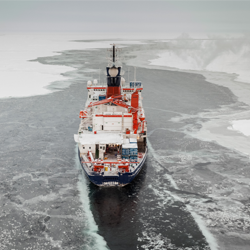
Despite disruptions due to the COVID-19 crisis, the station on board the Polarstern recently passed a demanding quality control programme and has now received the ICOS label for standardised greenhouse gas measurements. In September 2019, scientists took a major step in fundamentally understanding the Arctic region and how it is affected by global warming when they started the year-round research project MOSAiC. Dr. Mario Hoppema is one of the scientists contributing to this mission, the largest polar expedition in history. He analyses the partial pressure of carbon dioxide measurements monitored on board of the German research vessel for ICOS.
“Taking measurements in the central part of the polar region during the Arctic winter is exceptional and we are very happy to contribute to MOSAiC with our ICOS platform”, says Dr. Mario Hoppema. He is a chemical oceanographer working at the Alfred Wegener Institute in Bremerhaven. Alongside other tasks, he is responsible for continuous partial pressure of carbon dioxide (pCO2) measurements on board the Polarstern. The German icebreaker is the main platform for MOSAiC, the biggest international expedition launched in the Arctic aiming to understand the polar region’s complex climate system. For a whole year, teams of international researchers study the polar region to determine the effects of global warming on Earth.
“Measuring the oceanic pCO2 helps us analyse how much carbon dioxide has been taken up by the oceans”
Dr. Hoppema analyses the differences between atmospheric and ocean surface pCO2. “We have electricians on board the Polarstern that check the equipment and forward the data by email every week.” Ultimately, Dr. Hoppema’s goal is to analyse the carbon dioxide content in the surface ocean. “Measuring the partial pressure of carbon dioxide helps us to evaluate how much carbon dioxide has been taken up by the oceans”, Dr. Hoppema explains. Oceans are a major sink for atmospheric man-made carbon dioxide. Due to uneven mixing of the greenhouse gas in the ocean, many different measurements are needed. Currently, they are performed by a significant group of ICOS scientists.
ICOS class 2 label is the reward of a very long process
In the context of MOSAiC, it is a great achievement that the pCO2 station on board the Polarstern recently received an ICOS class 2 label. This is the reward for a long process of both the Ocean Thematic Centre and ICOS ocean community ensuring the data is harmonised and comparable. “If you imagine having different systems on different ships and they would also measure the same variable in different ways you could not compare the results” Dr. Hoppema explains. “It is, for example, unavoidable that pumping ocean water into the ship will warm up the water. This has influence on the pCO2 and needs to be carefully corrected.”
For the measurements, a strong pump draws water through a tubing system into the ship’s laboratory. The water is then equilibrated with air. The air contains carbon dioxide which can be determined by gas-phase infrared spectroscopy. As water is continually drawn into the ship, this process allows ICOS scientists to evaluate a time resolved series of carbon dioxide measurements. “The analysis of the data has not really started yet. However, in a preliminary analysis, I could already see much more variability in the data than I expected”, says Dr. Hoppema. “Processes causing this may be of physical nature (mixing of water masses, ice formation), or perhaps even of biological nature and they all have an impact on the pCO2 level. Please do not forget that this is just the first look at the data. We have to analyse it in more detail.”
“It is sad that we lost data for a couple of weeks but everyone is happy that we continue with this incredible project”
Luckily, the COVID-19 crisis did not affect Dr. Hoppema’s work – “Our system on board just worked the way it always did”. Nevertheless, there were quite a few disruptions caused by the pandemic. “The Polarstern had to leave its ice floe in the central Arctic and sail to calm waters off Svalbard in order to change researchers and transfer new equipment onboard. Once the exchange has been done the Polarstern went back to its ice floe”, explains Dr. Hoppema. Thanks to the support of additional research vessels, the MOSAiC expedition continued in June with a new team. “It is sad we lost data for a couple of weeks”, says Dr. Hoppema, “but everyone is happy that we can continue with this incredible project”.
When MOSAiC is finished, the Polarstern will support other expeditions in both Antarctic and Arctic as it has been doing for more than 35 years. During all of these expeditions the pCO2 system on board Polarstern will continue to take measurements for ICOS.
Photo credit and copyright: Mario Hoppmann, Alfred Wegener Institute